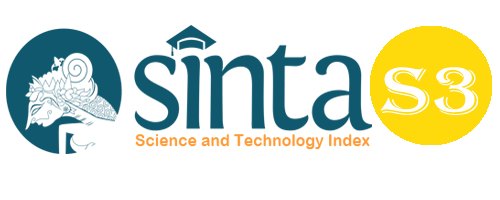Folklore as Ethnic Embodiment Bias: Value Analysis on Karo Folklore
Abstract
The existence of folklore as a folklore is assumed to be an entertaining story for children at bedtime. In fact, the folklore contains a lot of structured messages and messages conveyed implicitly. Folklore often reflects the creativity of traditional societies by still adhering to tradition as a manifestation of creativity that lives and is passed down from generation to generation. The study uses the opinion of Dundes (1965: 2) Bruvand (1965), Danandjaja (1997) and the concept of value according to Bascom in Danandjaja (1995: 3-20). Miles and Huberman's (2007) qualitative research methodology includes data collection of folklore texts, data presentation, and drawing conclusions or verification. Based on the analysis of folklore data, 10 folklore folklore were selected which were collected in the book Sukapiring et al. (1993). The results obtained based on the folklore text found ethnic values in folklore texts by interpreting behavioral trends as psychological symptoms based on the data found that the values in the Karo folklore data analyzed were found a) Educational values such as: the value of obedience to parents, the value of patience, b) Moral values found in folklore are the values of humility, forgiveness, and not being arrogant, and c) the religious values found in Karo ethnic folklore, namely: not being greedy, not playing gambling, and trusting. These values can represent the bias of the Karo ethnic community who instill values through folklore.
Keywords
Full Text:
PDFReferences
Amri, Yusni Khairul. (2020). Folklor Etnik: Kearifan Lokal Etnik sebagai Bias Nilai Budaya pada Folklor, Budapest International Research and Critics University (BIRCU-Publishing): Medan
Barnouw, Victor. (1982). Recreation, Folklor, and The Art.dalam An Introduction to Anthropology: Ethnology. Ontario: The Dorsey Press.
Bascom, William. (1965). Four Function of Folklor, Englewood Cliffts: Nj Press.
Danandjaja, James. (1995). A Comparative Study of Japanese and Indonesian Folklors. Southeast Asian Studies. Vol. 33, No.3: 202-213.
Danandjaja, James. (1997). Folklor Indonesia, Ilmu
Danandjaja, J. (2007). Folkor Indonesia. Jakarta: Pustaka Utama Grafiti.
Danandjaja, James. (2007 (Cet. VII). Folklor Indonesia: Ilmu Gosip, Dongeng, dan Lain-lain. Jakarta: PT Pustaka Utama Grafiti.
Dundes, Alan. (1965. (Ed.) The Study of Folklore. New Jersey. Prentice-Hall, Inc.
Dundes, Alan. (1965. Interpreting Folklore. Bloominton: Indiana University Press.
Moleong, Lexy J. (2010. Metodologi Penelitian Kualitatif. Remaja Rosda Karya: Bandung.
Ginting, P. (2019). Music Creation Based on Folklore. Budapest International Research and Critics Institute-Journal (BIRCI-Journal). p. 271-278
Sukapiring, Peraturen et a (1993. Folklor Lisan Karo. Departemen Pendidikan dan Kebudayaan: Jakarta.
Purwadi. (Folklor Karo. Yogyakarta: Pura Pustaka.
Sugono, Dendy. (ed.). (2005. Buku Praktis Bahasa Indonesia Jilid 1. Jakarta: Pusat Bahasa Departemen Pendidikan Nasional.
Sugono, Dendy. (ed.). (2005. Buku Praktis Bahasa Indonesia Jilid 2. Jakarta: Pusat Bahasa Departemen Pendidikan Nasional.
Sumber Internet:
http://arianus.wordpress.com/2010/03/13/budaya-karo diakses tanggal 01 Februari 2020.
http://www.karoweb.or.id/karo-dan-sifat-merganya diakses tanggal 05 Februari 2020.
https://www.pariwisatasumut.net/2019/07/upacara-adat-suku-karo.html diakses tanggal 17 Februari 2020.
https://karokab.go.id/id/potensi-daerah/pariwisata/upacara-tradisional diakses tanggal 05 Februari 2020.
www.karosiadi.blogspot.com diakses pada tanggal 05 Februari 2020.
http://isabellemarissa.blogspot.com/2013/11/makalah-ilmu-kebudayaan-batak-karo.html diakses pada tanggal 05 Februari 2020.
www.wikipedia/aksara-karo.com diakses pada tanggal 05 Februari 2020.
www.budaya-karo.wordpress.com diakses pada tanggal 05 Februari 2020.
DOI: https://doi.org/10.33258/birci.v3i4.1273
Article Metrics
Abstract view : 206 timesPDF - 152 times
Refbacks
- There are currently no refbacks.

This work is licensed under a Creative Commons Attribution-ShareAlike 4.0 International License.

This work is licensed under a Creative Commons Attribution-ShareAlike 4.0 International License.

_.gif)

















_.gif)



